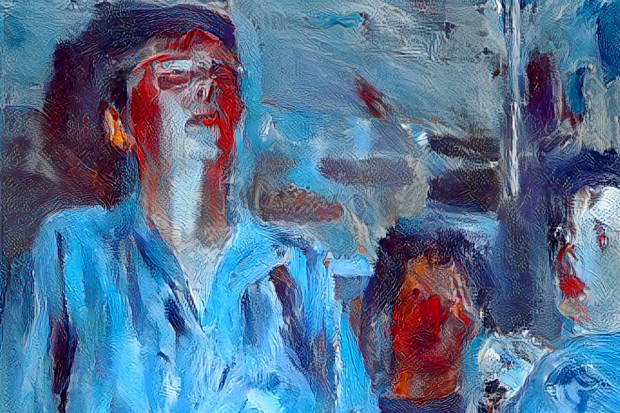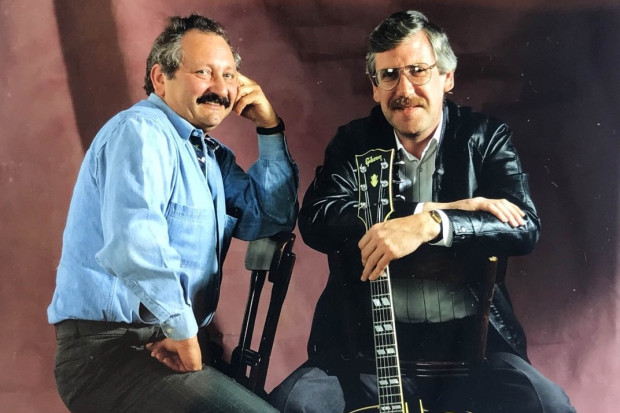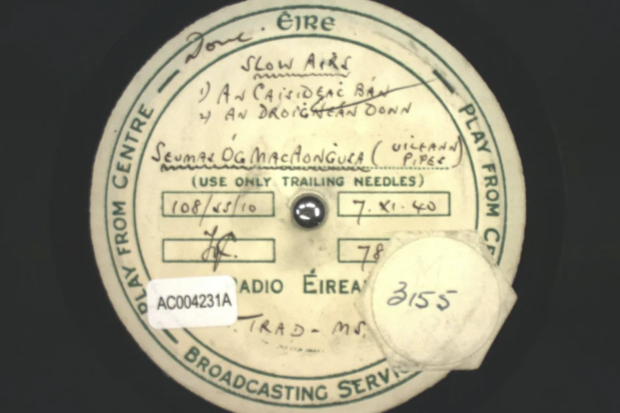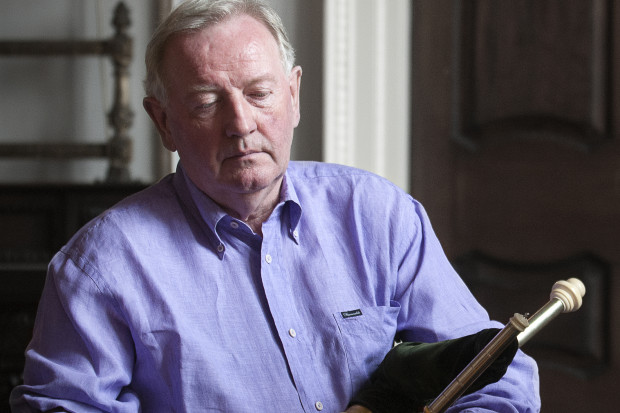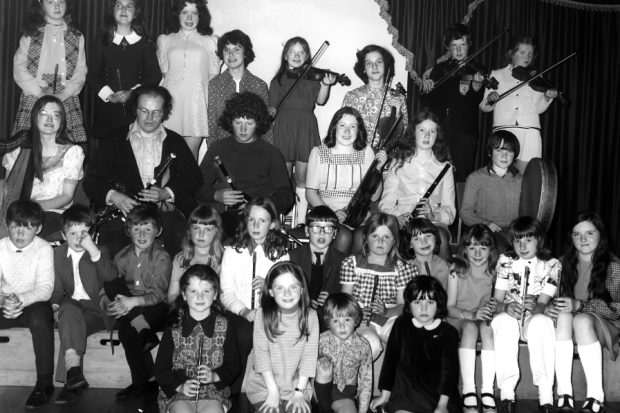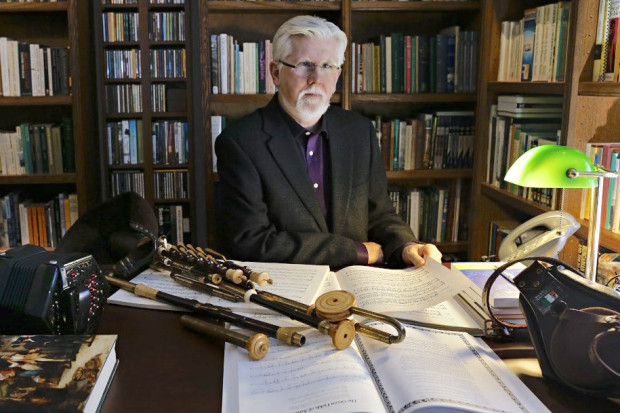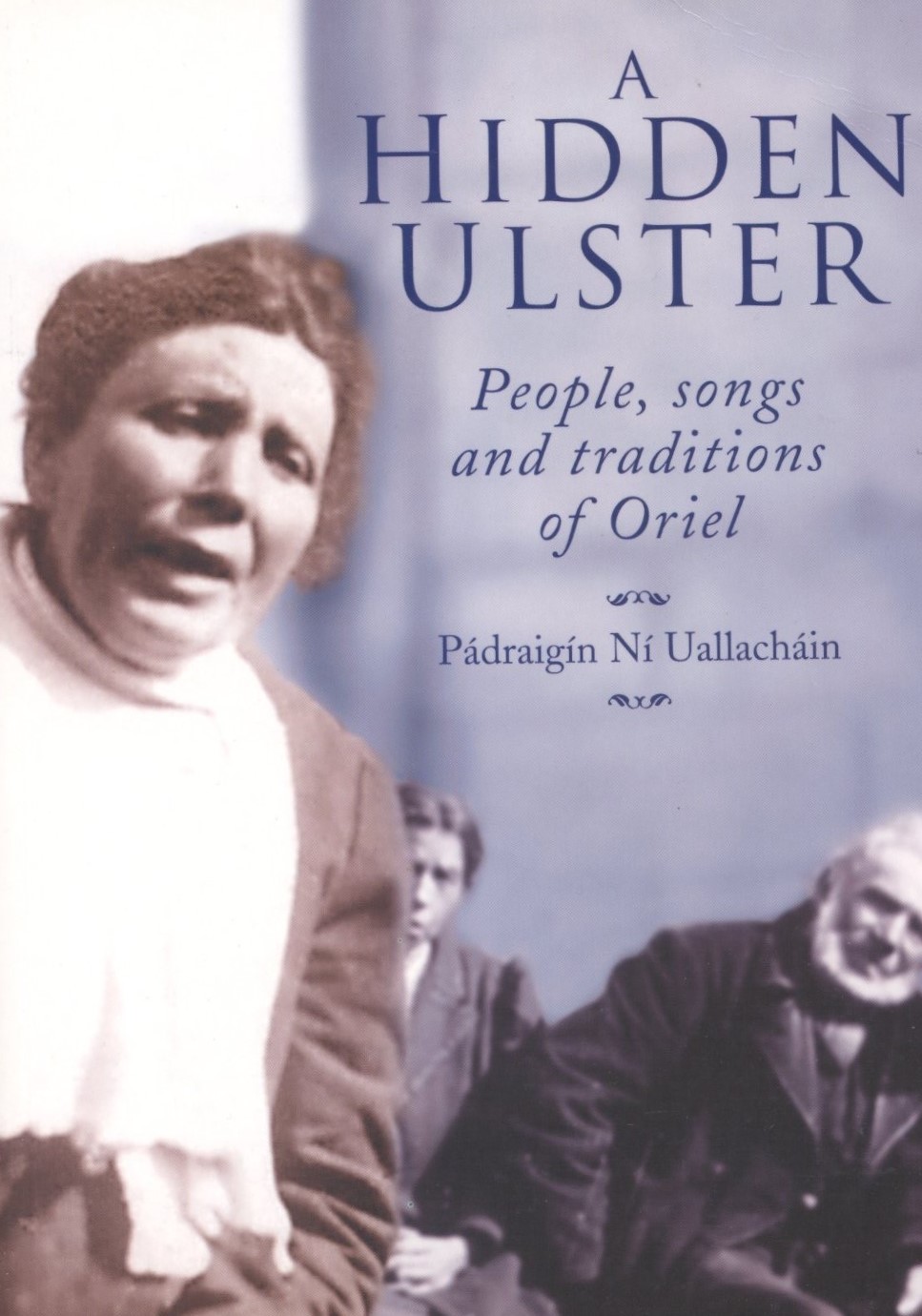
A Hidden Ulster
Breathing on the Embers
A Hidden Ulster: People, Songs and Traditions of Oriel
Pádraigín Ní Uallacháin
Four Courts Press, Dublin 2003540pp; ISBN 1-85182-685-8 hbk (≠65); ISBN 1-85182-738-2 pbk (≠29.95).
This is a book of which I was aware was long in gestation and which I looked forward to. Even being conscious of its imminent birth I was surprised by its sheer physical size when it arrived. It may be expensive, but it is a great slab of a book.
The rather clichéd title does it a disservice, for I feel that the song lore of this region has been neglected rather than hidden and there have been a number of enthusiastic proselytisers for the Gaelic culture of Oriel of which Ms Ní Uallacháin is but the latest. However, she may well be one of the most effective and her work will certainly be seen as a catalyst in drawing the work of her predecessors together.
Her chosen area of study, her native Oriel, is not one that comes readily to mind to most of us when we think of Gaelic tradition nowadays. Indeed, when asked to explain its location on the RTÉ Radio One arts programme Rattlebag,[1] Ms Ní Uallacháin proceeded to explain that it included parts of Louth, Monaghan and Armagh when the penny dropped with her interviewer, Myles Dungan: ‘Ah, Tommy Makem country!’ he exclaimed. Although Sarah Makem, Tommy’s mother, could take her place in any gathering of the finest traditional singers in the land, her son would be lost in the shadows of the superlative poets like Art McCooey (Mac Cumhaigh), Séamus Dall Mac Cuarta, Peadar Ó Doirnín and many more known and anonymous song makers who bedizen the pages of this book.
From the outset its very originality make it a difficult work to pigeon-hole. One asks oneself the standard questions: Is it academic? Yes, the author’s deep learning and grasp of her subject are everywhere evident. Is it informative? Yes, she has the very welcome ability to marshal her thoughts clearly and communicate her research and erudition with enthusiasm. Is it an ethnographic work? Yes, in the broadest sense, she works on every level from describing the manners and customs of the region to passing on local gossip about the songmakers and their subjects. Is it a musicological or literary work? It is both. The work of the known poets are examined in minute detail by someone with a profound understanding of the literature of the area. Music is given for every song and references are supplied to all known relevant versions. This is done by an someone who not only knows the theory of the song lore of Oriel, but is also a practitioner and an extremely fine singer who has made a recording of each and every song in the book [see the review of An Dealg Óir on p. 19].[2] It is this aspect which gives such a vibrancy and passion to the book. A study it may be, and a fine one at that, but its main objective is to restore this extremely important corpus of traditional song to life and re-forge the link to this chain which has only so very recently been broken. What was said about the Oriel collector, Lorcán Ó Muiraí, could perhaps apply to her, that she is ‘driven by a desperate zeal’. Though, having read the book I am more inclined to think that what we have here is not the work of a zealot, but the work of a lover.
A sense of responsibility
She has stated that her decision to write the main body of the book in English was in order to ensure maximum accessibility for all who approach it. The songs are given in the original Irish as collected in South East Ulster, followed by the author’s translation and extremely extensive notes and appendices. Although she maintains that her motivation in compiling this collection was ‘a sense of responsibility to my own people’,[3] there can be no doubt that the writer’s initial inspiration for her magnum opus was her late father Pádraig Ó hUallacháin (Paddy Weldon, 1912-1974) who passed on to her and all his family his love of the Irish language and the Gaelic tradition of Oriel. He was also a singer and collector and, in many ways, A Hidden Ulster can be seen as a continuation of his work, a repaying of a perceived debt to her father in particular as well as a sense of nobless oblige to her dúchas, her heritage, in general. Many collectors contribute to the book and Ó hUallacháin is given his rightful place amongst them.
Among the most dominant figures featured in the book are two priest collectors, Lorcán Ó Muirí and Luke Donnellan, the latter of whom left a legacy of wax cylinders which he recorded and which were transcribed by Séamus Ennis in the 1940s.[4] Many of these musical transcriptions are reproduced in the book. The fact that we owe so much to these clerical collectors is particularly interesting in the light of the author’s meticulously researched introduction in which she outlines the destructive effects of the Roman Catholic clergy in trying to obliterate the Irish language in Oriel in the nineteenth century. Clergy who could speak and proselytize in Irish were frequently members of the protestant Irish Society, a bible society which took the trouble to learn the language of the people amongst whom they worked. Ergo, if they were Irish-speaking clergy they must be protestants to be avoided at all costs. The Roman Catholic clergy of the region even went so far as to state that ‘the Irish language is a threat to the people’s faith’. With attitudes like that we can only thank providence for Donnellan and Ó Muirí.
Much of what we know about the song of Oriel comes from such publications as Ó Muirí’s Ceolta Oméith and Amhráin Chúige Uladh. As well as making his recordings, Donnellen published several articles on traditional song in the County Louth Archaeological Journal. Perhaps better known than either of these was Enrí Ó Muiríosa (Henry Morris, ‘The man of Farney’), author of many books on Gaelic poetry and song. Two of these, Céad de Cheoltaibh Uladh (1915) and Dá Chéad de Cheoltaibh Uladh have been the standard reference points for Ulster Gaelic song texts for many years. Naturally Ó Muiríosa contributes to the contents of A Hidden Ulster.
Breathing gently on the embers
The work of no less than twenty-five relevant collectors and scholars are drawn together by Ní Uallacháin and it is this awareness of printed, manuscript and aural documents which make this such an important overall picture of a cultural flame which burned for so long. And even if the flame has flickered out, the ashes are still warm and she is breathing gently on the embers to coax a glow from them once again.
The collectors are given individual attention, all are given biographies and many appear in the marvellous photographs of Peadar Ó Dubhda, another great Oriel enthusiast whom some older readers may remember from his radio broadcasts.
These glass plate photographs are not merely reproductions or portraits of individuals, they catch the lifestyle of Oriel in the early twentieth century. We see people at work harvesting, tilling, spinning or at play dancing and singing. Ní Uallacháin treats the folklife of Oriel in great detail and we are given extended essays on traditions like the harvest calliach, the cutting of the last sheaf. She conducts a fascinating examination of ritual songs such as May songs and states that ‘South East Ulster is the richest source of seasonal songs in Ireland to date’. She then goes on to give a great deal of evidence to back up this claim. Everywhere that accounts of the manners and customs of the people illuminate the song texts these traits are scrutinised in detail. The turbulent history of pattern days follows Patrún Chill Shléibhe, an extended treatise on traditional laments comes after An Bhean Chaointe, and so on throughout this very discursive work.
Naturally, the importance of the singers themselves is given priority and whatever could be found out about them, which was often quite a lot, Ní Uallacháin has reproduced. On a recent television programme she commented that her work has drawn her so close to the singers themselves that she feels as if she knows them as personal friends and were she to encounter their apparition she ‘would not be one bit afraid’ to embrace them.[5] This sense of engagement is obvious throughout the book which certainly has enough scholarly content to merit a PhD. When I asked her about this she said that such a route had indeed been suggested to her several times, but she finally decided to abandon it and chose to present her work from the viewpoint of a singer and a native of the region. If this meant eschewing some of the academic conventions in conveying her work into print, so be it. Her loyalty is to the singers who passed on the torch to her and, hopefully, to those to whom she can pass it on in her turn.
The book differs from accepted academic presentation in that the songs are presented in many cases in collated versions, but this is to ensure their singability. In all cases we are given the sources of each and every verse so that if the reader/singer wishes to peruse the original texts they are told where to look. So, both the singer and the academic are catered for in relation to every song.
The spirit of the songs
Of the songs themselves, McCooey, Mac Cuarta, Ó Doirnín and Cathal Buí Mac Giolla Ghunna are well represented and the versions of their songs given here have in most cases been through the filter of comparatively recent oral tradition. As would be expected, the majority of the songs are anonymous. Even so, many of these songs reach a plane of excellence often coupled with a deceptive simplicity which would be the envy of many of the great writers of more formal verse. Such a song, to my mind is An Bhean Chaointe, in which a mother is deranged by the loss of her daughter. This lament is found only in the Gaelic song tradition of South East Ulster. The údhar (authority/explanation) behind the song tells us that the grieving woman had already lost eleven children.
A Neillí bhán dheas, go mbeannaí Dia d(h)uit!
Go mbeannaí ‘n ghealach bhán ‘s an ghrian d(h)uit!
Go mbeannaí na haingil ‘tá I bhflaitheas Dé d(h)uit!
Mar a bheannaíonn(s) do mháthair a chaill a ciall dhuit.Tá an ghrian ‘s a ghealach ag triall faoi smúid;
Tá réaltaí na maidne ag sileadh na súl;
Tá na spéarthaí in airde fá chulaith chumaidh
Is go dtillfidh tú aríst cha luíonn an drúcht.(Fair Nelly, may God Bless you!
May the white moon and the sun bless you!
May the angels in God’s heaven bless you!
And your poor mother who lost her reason for you, blesses you.The sun and moon are moving in shadows;
Teardrops fall from the morning stars;
The skies above are in a cloak of sorrow
And until you return again the dew does not lie.)
This jewel of a song is followed by no less than a dozen pages of elucidation and contextual information.[6]
There is really no point in selecting individual songs for separate attention. All fifty-four items are at the very least interesting and most are fascinating. The Irish text is presented first and this is followed by the author’s translation. Given her empathy with her subject and (once again) the fact that she is a singer, these translations are not always exactly literal but invariably catch the spirit of the song. In the case of the music given for the songs this is a little more problematic in that these are reproductions ranging from sol-fa notation of varying legibility to the pellucid transcriptions of Séamus Ennis. Asked if it would not have been better to have all of the musical examples re-set and published in uniform staff notation, Ní Uallacháin said that given a choice between doing that and reproducing the actual artefacts which represent part of the tangible residual tradition, she chose the latter. The preference for this reviewer would have been to do both, but given the already high cost of publication this was hardly a realistic option.
But in so many other ways the book does not stint, it gives exhaustive coverage of material printed in the Dundalk Democrat, collections such as Seán Ó Hannáin’s and Pádraig Ó hUallacháin’s. Patrick McGahon’s manuscript collection of music from the early nineteenth century is reproduced in facsimile as are tunes from the repertoire of the piper Philip Goodman and the song airs and dance music from the collection of the County Louth Archaeological Journal. Aside from the body of the work and footnotes there are thirty pages of bibliographical reference and indices.
A Hidden Ulster is incredibly exhaustive. It may have taken a considerable time to complete, but the end result stands as an exemplar as to just how well such things can be done. As I said initially, it is not cheap, but this big generous book is nevertheless exceptional value. If you can afford it I would suggest buying the hardback because it is a book you will be referring to for many years to come. Not only will it rapidly take its place among the great works on Irish song written within the last century, I am convinced its importance will be undiminished at the end of this, twenty-first, century.
Notes
1. 16 October 2003.
2. A set of CDs of the author’s unaccompanied singing of all these songs is in the final stages of preparation.
3. Rattlebag, 16 October 2003.
4. These cylinders are now in the possession of the Department of Irish Folklore, University College, Dublin, and are currently being digitally remastered.
5. The Raw Bar, RTÉ 1, 15 November 2003.
6. Pádraigín Ní Uallacháin may be heard singing this herself on the CD An Dara Craiceann – Beneath the Surface, Gael Linn CEFCD 183, Dublin, 1995.
Published on 1 January 2004
Tom Munnelly (1944-2007), born in Dublin but resident in Miltown Malbay, Co Clare, since 1978, made the largest field-collection of Irish traditional song ever compiled by any individual. After recording privately in the 1960s, and collecting especially from Traveller singers, he became a professional folklore collector and archivist with the Department of Irish Folklore, University College Dublin (now the UCD Delargy Centre for Irish Folklore and the National Folklore Collection), from 1974 to date, with a concentration on English-language song. He lectured and taught widely, was a leading activist in many folk music organisations and festivals, including the Folk Music Society of Ireland, the Willie Clancy Summer School and the Clare Festival of Traditional Singing, and he served on national bodies such as the Arts Council. He was the founding Chairman of the Irish Traditional Music Archive from 1987 to 1993. Recently he was presented with the festschrift Dear Far-Voiced Veteran: Essays in Honour of Tom Munnelly, and was made an honorary Doctor of Literature by the National University of Ireland Galway.










